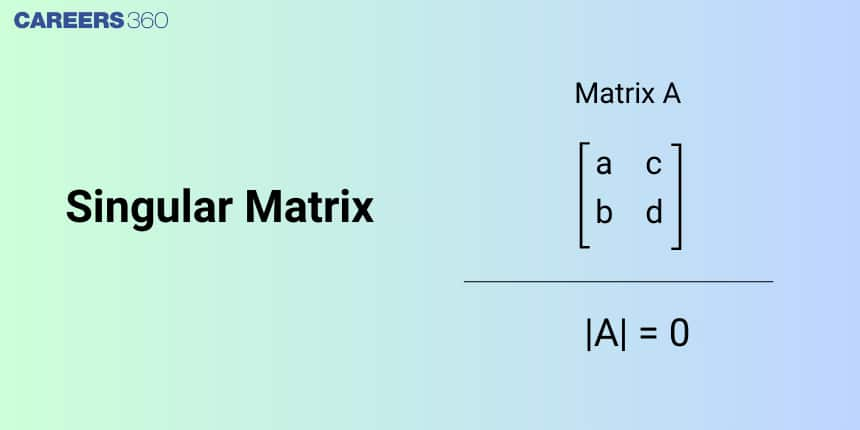Singular Matrix
Before we start with the concept of a Singular and non-singular matrix, let’s first understand what is a matrix. A rectangular arrangement of objects (numbers or symbols or any other objects) is called a matrix (plural: matrices). A matrix is only a representation of the symbol, number, or object. It does not have any value. Usually, a matrix is denoted by capital letters. Matrix of order m × n, (read as m by n matrix) means that the matrix has m number of rows and n number of columns. In real life, we use Singular and non-singular matrices to solve systems of linear equations, quantum mechanics, and optics.
JEE Main: Study Materials | High Scoring Topics | Preparation Guide
JEE Main: Syllabus | Sample Papers | Mock Tests | PYQs
- Determinant of matrix
- Singular and non-singular matrix
- Properties of Determinants
- Solved Examples Based on Singular and Non-Singular Matrices

In this article, we will cover the Singular and non-singular matrix. This category falls under the broader category of Matrices, which is a crucial Chapter in class 12 Mathematics. It is not only essential for board exams but also for competitive exams like the Joint Entrance Examination(JEE Main) and other entrance exams such as SRMJEE, BITSAT, WBJEE, BCECE, and more. A total of twenty-six questions have been asked on this topic in Jee mains (2013 to 2023), two in 2013, two in 2014, two in 2015, one in 2016, six in 2019, two in 2020, four in 2021, three in 2022, and three in 2023.
Determinant of matrix
The determinant of a matrix A is a number that is calculated from the matrix. For a determinant to exist, matrix A must be a square matrix. The determinant of a matrix is denoted by det A or |A|.
For
then
For a
then we find
This same process we follow to evaluate the determinant of the matrix of any order. Notice that we start the first term with the +ve sign then 2nd with the -ve sign and 3rd again +ve sign, this sign sequence is followed for any order of matrix.
This whole process is row-dependent, the same process can be done using columns, which means we can select an element along a column delete their row and column compute the determinant of left out matrix, and then multiply it with the element that we select. And we will get the same result as we get while doing the whole process along the row.
Singular and non-singular matrix
A square matrix is called a singular matrix if its determinant is 0 otherwise it is called a non-singular matrix. Let's say A is a square matrix then it is singular if |A| = 0, otherwise, it will be non-singular if |A| ≠ 0.
Properties of Determinants
If A and B are square matrices of same order:
i) The determinant of the transpose of matrix A is equal to the determinant of matrix A. det (A’) = det A
ii) The product of the determinant of matrices AB is equal to the product of the determinant of individual matrices. det (AB) = det (A) det (B)
iii) The determinant of the skew-symmetric matrix of odd order is zero. if A is the skew-symmetric matrix of odd order then |A| = 0.
iv) The determinant of the skew-symmetric matrix of even order is a perfect square. if A is a skew-symmetric matrix of even order then |A| is a perfect square.
v) |kA| = kn |A|, where n is the order of matrix A and k is a constant.
vii) |An| = |A|n, where n belongs to N.
viii) |AB| = |BA|
Recommended Video Based on Singular and Non-Singular Matrix:
Solved Examples Based on Singular and Non-Singular Matrices
Example 1: Let
If
whose first term is
Solution
Hence, the answer is 495.
Example 2:
Let
[JEE MAINS 2023]
Solution:
now
satisfied by
Now, if
if
Hence, the answer is 3
Example 3: The probability that a randomly chosen
[JEE MAINS 2022]
Solution: Let the matrix A be
If A is singular then
Case I
a can take 10 values.
d can take the value which equals a
Now for ad
Total such matrices
Case II:
In this case, can take 10 values and
Now for
or
Hence, the answer is $\frac{19}{10^3
The value of
[MAINS 2021]
Solution: Put a
OR
Given matrix is
Hence, the answer is -2
example 5: If the minimum and the maximum values of the function
are
[JEE
[MAINS 2020]
Solution
Hence, the answer is
Frequently Asked Questions (FAQs)
A square matrix is called a singular matrix if its determinant is 0. Let's say A is a square matrix then it is singular if |A| = 0
The determinant of a matrix A is a number that is calculated from the matrix. For a determinant to exist, matrix A must be a square matrix. The determinant of a matrix is denoted by det A or |A|.
The product of the determinant of matrices AB is equal to the product of the determinant of individual matrices. det (AB) = det (A) det (B).
The determinant of the skew-symmetric matrix of odd order is zero. if A is the skew-symmetric matrix of odd order then |A| = 0. whereas, The determinant of the skew-symmetric matrix of even order is a perfect square. if A is a skew-symmetric matrix of even order then |A| is a perfect square.
The determinant of the transpose of matrix A is equal to the determinant of matrix A. det (A’) = det A
Also Read
15 Feb'25 11:01 AM
15 Feb'25 10:43 AM
14 Feb'25 12:44 PM
14 Feb'25 12:41 PM
14 Feb'25 11:14 AM
14 Feb'25 11:08 AM
14 Feb'25 11:02 AM
14 Feb'25 10:58 AM
14 Feb'25 10:55 AM
14 Feb'25 10:43 AM

